Cyclists often ask: what is the optimal chain length for a bicycle with derailleurs? Should I shorten a new chain, and by how much? I’ll answer those questions in this article. For single speed bicycles (or bikes with internal gear hubs), see: Determining optimal single speed chain length.
TL/DR
Here, I’ve explained:
- Why it’s important to cut your chain to the optimal length?
- How to measure that (before cutting 🙂 ) for 1-X vs double and triple crank drivetrains?
- What can you do if your chain is too long for your RD cage to handle?
1. Bicycle drive chain length
A new bicycle chain usually comes with 116 links. This is long enough for the biggest chainrings and for most distances of rear wheel from front chainrings. So for optimal length a new chain is usually shortened from the 116 links that come in the box. In rare occasions – touring frames for example, with extremely long chainstays, 116 links might not be long enough, so a few links off another new chain need to be added to reach optimal chain length.
2. The importance of determining the correct chain length
Too long chain will increase risk of chain dropping, while too short chain puts too much stress on the drivetrain, or can damage it, if it can be put and closed over the chainrings in the first place. Chain that is too short can also damage rear derailleur.
3. Chain length sizing for bicycles with derailleurs
There are several methods for getting the chain at the correct length. The method explained here is certain to result in a chain long enough not to cause any drivetrain damage. The method is called “big-big”.
In order to make absolutely sure the chain is long enough, it should be put around the biggest chainring in the front, the biggest sprocket at the rear and then add one more inch, i.e. one link because of the derailleur (one link consists of a pair of outer and inner plates, as shown in the picture below – it is often referred to as “two links”). When measuring, the chain is not put through the rear derailleur, the derailleur is moved so it doesn’t get in the way.
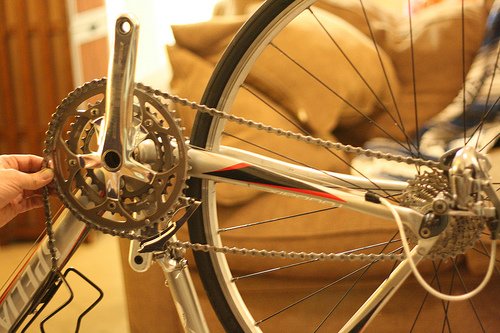
This makes the chain one inch longer to accommodate the rear derailleur.
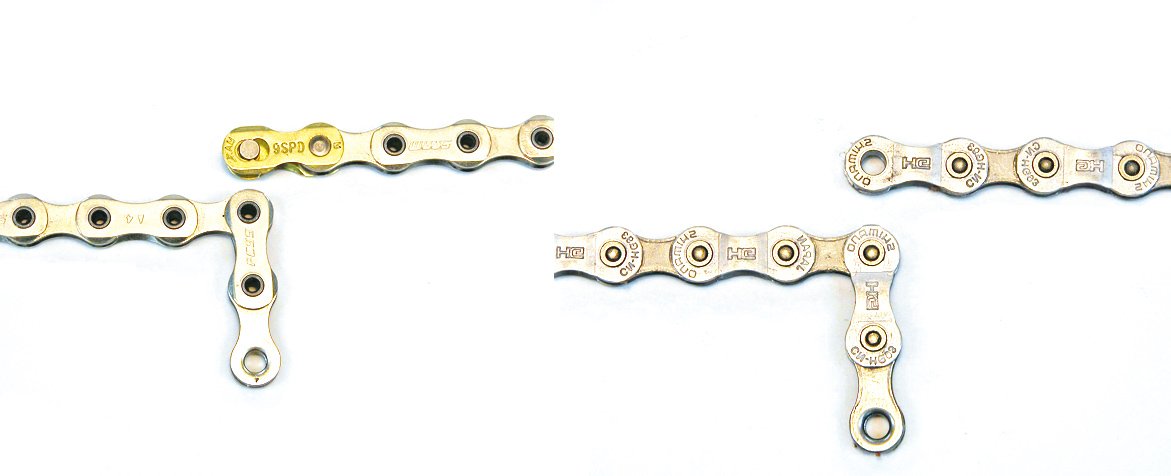
On the left is a chain with a quick link, while on the right is a “standard” chain using a connecting pin.
For bicycles with rear suspension, the suspension should be totally bottomed – compressed when using this method. See the position of travel where the rear wheel is furthest away from the cranks. To achieve this with air shocks just let the air out, while for ones with spring one has to remove the shock, remove the spring, then put the shock back. Simpler, though not 100% reliable method is adding one extra pair of inner and outer links to the length determined by the method explained below.
With modern, more and more popular systems that have one chainring in the front and multiple chainrings in the back (“1x” systems), the optimal length is achieved when adding two extra links, instead of just one, after wrapping the chain around the only front chainring and the largest rear sprocket.
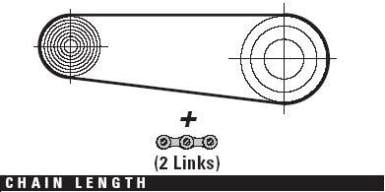
For bicycles that have more than one front chainring, i.e. those with a front derailleur.
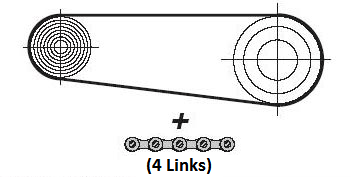
For bicycles with only one front chainring, i.e. without a front derailleur.
(see pros and cons of 1x drivetrains)
That’s all. A simple method. What to look out for?
4. Rear derailleur chain wrap capacity not big enough
Rear derailleur chain wrap capacity may not be big enough.
The explanation of what RD capacity is can be found under “Derailleur capacity” in this page: Rear derailleur.
This results in a situation that in a small-small chainring combination, the chain is too slack and can even fall off chainrings on bumpy roads.
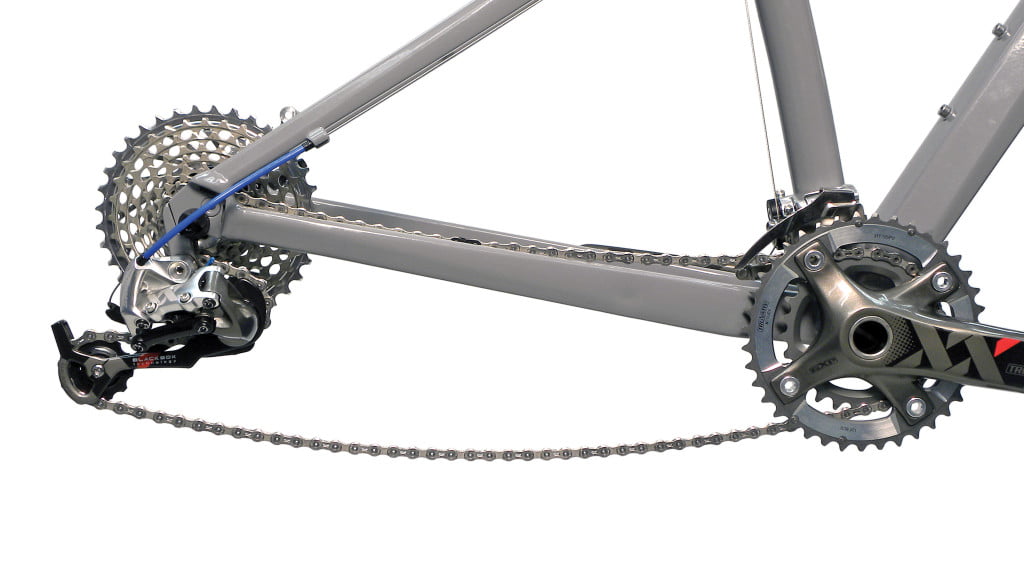
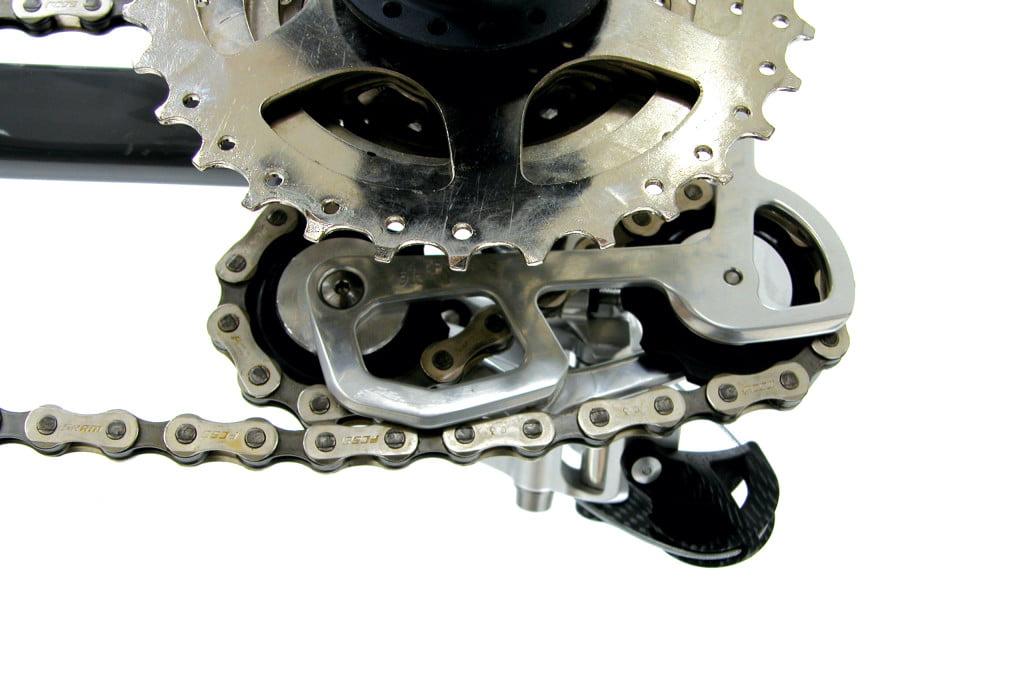
Bottom part of the chain is rubbing the top RD jockey wheel.
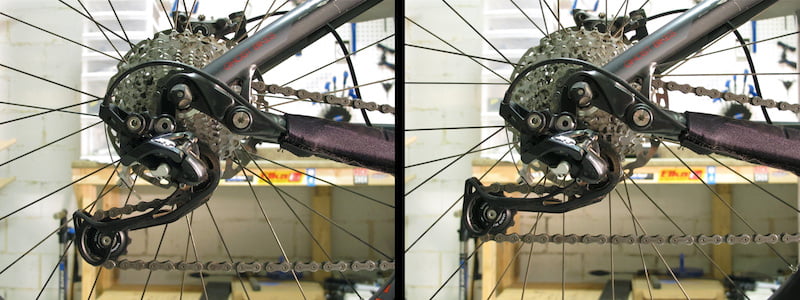
Chain to the right is still a bit too long for the RD wrap capacity, just not as extreme as in the two pictures above.
RD cage is parallel to the ground, making it hard for the RD to tighten the chain strongly enough.
This problem can be solved in three ways:
- Getting a rear derailleur with a longer cage.
- Avoiding smallest few sprockets at the cassette when the chain is on the smallest chainring in the front.
- Shortening the chain.
The third method is potentially dangerous, because in a big-big combination the chain will no longer be long enough. This can result in tearing the rear derailleur when changing to the biggest sprocket at the rear if the big chainring is used in the front.
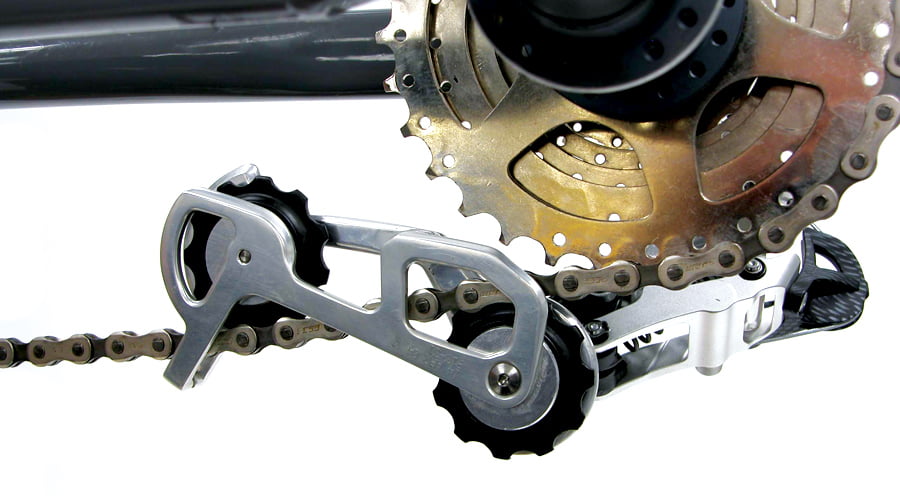
It managed to shift into big-big combo, but there is almost no bend at the derailleur jockey wheels.
Small-small and big-big combinations are combinations to avoid anyway, because the chain is cross-chained in those combos, the same gear ratio can be achieved with a middle-middle combination easily. Still, it can happen that in a moment of lesser caution, one does shift into one of those combinations. That is why, if method 1 is not possible for any reason (financial or some other), it is safer to use method 2 than method 3.
5. Shortening and re-connecting bike chains
For this, I’ve made a video demonstration:
Last updated:
Originally published:
Related post – How to lubricate a bicycle chain:

The existing comments posted under this article (questions and answers) have been moved to this BikeGremlin forum thread:
https://www.bikegremlin.net/threads/chain-length-sizing-for-bicycles-with-derailleurs-article-comments.124/

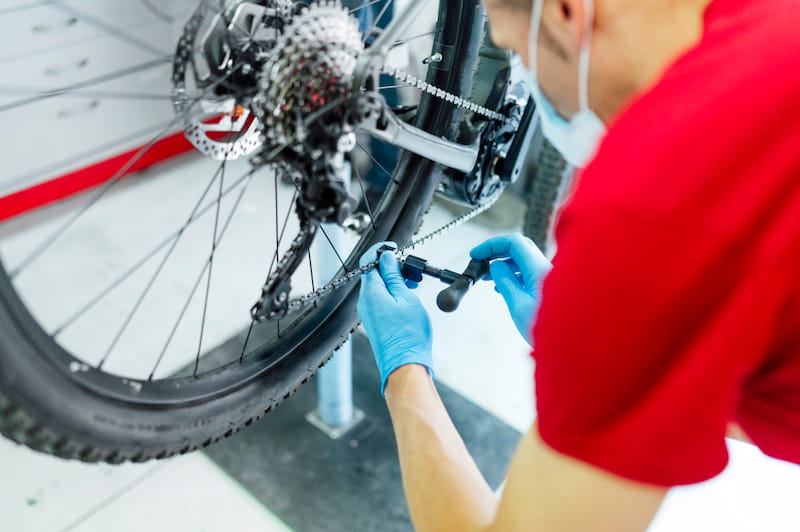
I have found that a very quick and precise way to see whether you can accommodate a cog slightly larger than the current largest cog is to select the current/big combo and then assess the chain slack by seeing how far you can push chain down at about the middle of its upper run. The chain can typically go down by at least a few inches as the derailleur cage gives up the slack. For typical chainstay lengths, a 3 inch drop means you can add one tooth with the current chain. A drop of 4.5 inches allows a two tooth increase. If you follow this procedure, the chain will likely grumble a bit on the new big/big combo. But that can be useful as a warning not to stay in that combo if you inadvertently select it.
Thanks. Will give this a try. I usually take the lower part of the chain in the big-big combo, holding two links that are not adjacent, pulling them towards each other. If there’s RD cage movement left, it will allow for the links to come closer. Depending on how much “movement” can be done this way, you can tell approximately how much more teeth can be accommodated. Just over 0.5 extra inch movement per extra tooth.
very informative information, thank you. been working on bikes for many years, and have always been curious about chain length versus derailleur position. since all I work on are mostly discarded or donated bikes I build for poorer folk, I am not always as fastidious as could be. now I can be that much better.
When you say “and then add one more inch, or one link because of the derailleur”, don’t you mean “and then add one more inch, or one link PAIR because of the derailleur”?
Well noted. I mean “one pair of inner and outer plates” – one inch in length.
I have edited the text to make it less ambigous.
Hello,
I was thinking about a new ProX o-ring chain for my dirt bike, but would like to know your suggestions on how to clean and re-lubricate the chain so that I don’t harm the o-rings or wash out the internal grease. I don’t mind taking the chain off – Can I swish the chain in a solvent tank? How do you guys do it?
Thank you,
Hi Raymond,
Just to avoid any misunderstanding – are we talking about motorcycles or bicycles?
If it’s bicycles – what are the riding conditions: sand, dust, mud, snow, or a combination of those?
Relja